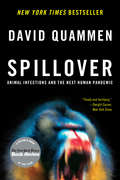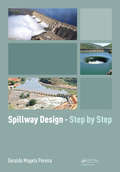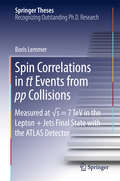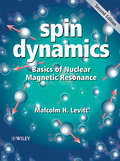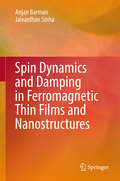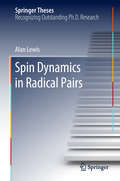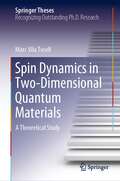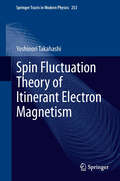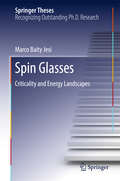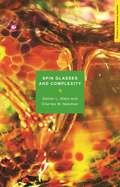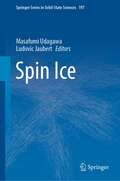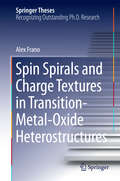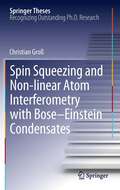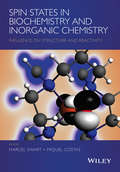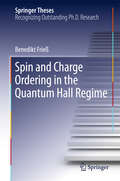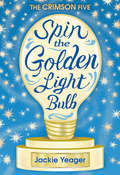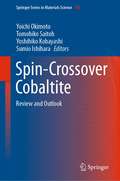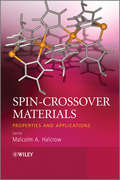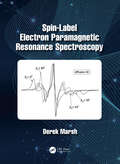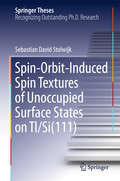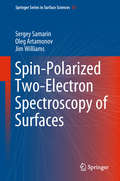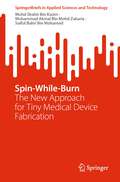- Table View
- List View
Spillover and Feedback Effects in Low Carbon Development
by Youguo ZhangThis book studies the pathways and policies of regional coordinated low carbon development from the perspective of regional spillover-feedback effects. How do regional economies interact with carbon emission? This phenomena, also known as spillover-feedback effects, is explained in depth with reference to datasets and real examples. As China adopts zero-carbon emissions policies within the context of regional disparities, this theoretical construct is gaining utility, and in this book, climate science researchers and political scientists will find it explicated as never before.
Spillover: Animal Infections And The Next Human Pandemic
by David Quammen"Science writing as detective story at its best." --Jennifer Ouellette, Scientific American A New York Times Notable Book of the Year, a Scientific American Best Book of the Year, and a Finalist for the National Book Critics Circle Award. Ebola, SARS, Hendra, AIDS, and countless other deadly viruses all have one thing in common: the bugs that transmit these diseases all originate in wild animals and pass to humans by a process called spillover. In this gripping account, David Quammen takes the reader along on this astonishing quest to learn how, where from, and why these diseases emerge and asks the terrifying question: What might the next big one be?
Spillway Design - Step by Step
by Geraldo Magela PereiraMost dam accidents with hydroelectric plants are due to under-dimensioning of the maximum floods of spillway design, causing extravasation and dam breaks (this occurs in 23% of the accidents). This work highlights the relationship between spillway design and potential dam failure and other important aspects of these structures and presents the methodology of design based on the international experience on the subject. The book covers river basin studies and floods (the geology, geomorphology, hydrology, hydraulics, and layouts of the works). Further, spillway function, capacity and design flood, layouts, or arrangements, of hydroelectric works and types of spillways are treated in the book. Finally, the book discusses examples of dams that broke due to insufficient spillway capacity. The book is intended for engineers and the companies that design dams and power plants around the world, as well as students in dam and hydraulic engineering. In short, people interested in producing electricity that is clean and potentially cheaper than other sources.
Spin Correlations in tt Events from pp Collisions
by Boris LemmerThis thesis introduces readers to the Standard Model, the top quark and its properties, before explaining the concept of spin correlation measurement. The first measurement of top quark spin correlations at the LHC in the lepton+jets decay channel is presented. As the heaviest elementary particle, the top quark plays an essential role in the Standard Model of elementary particle physics. In the case of top quarks being produced in pairs at hadron colliders, the Standard Model predicts their spins to be correlated. The degree of correlation depends on both the production mechanism and properties of the top quark. Any deviation from the Standard Model prediction can be an indicator for new physics phenomena. The thesis employs an advanced top quark reconstruction algorithm including dedicated identification of the up- and down-type quarks from the W boson decay.
Spin Dynamics
by Malcolm H. LevittSpin Dynamics: Basics of Nuclear Magnetic Resonance, Second Edition is a comprehensive and modern introduction which focuses on those essential principles and concepts needed for a thorough understanding of the subject, rather than the practical aspects. The quantum theory of nuclear magnets is presented within a strong physical framework, supported by figures. The book assumes only a basic knowledge of complex numbers and matrices, and provides the reader with numerous worked examples and exercises to encourage understanding. With the explicit aim of carefully developing the subject from the beginning, the text starts with coverage of quarks and nucleons and progresses through to a detailed explanation of several important NMR experiments, including NMR imaging, COSY, NOESY and TROSY. Completely revised and updated, the Second Edition features new material on the properties and distributions of isotopes, chemical shift anisotropy and quadrupolar interactions, Pake patterns, spin echoes, slice selection in NMR imaging, and a complete new chapter on the NMR spectroscopy of quadrupolar nuclei. New appendices have been included on Euler angles, and coherence selection by field gradients. As in the first edition, all material is heavily supported by graphics, much of which is new to this edition. Written for undergraduates and postgraduate students taking a first course in NMR spectroscopy and for those needing an up-to-date account of the subject, this multi-disciplinary book will appeal to chemical, physical, material, life, medical, earth and environmental scientists. The detailed physical insights will also make the book of interest for experienced spectroscopists and NMR researchers. * An accessible and carefully written introduction, designed to help students to fully understand this complex and dynamic subject* Takes a multi-disciplinary approach, focusing on basic principles and concepts rather than the more practical aspects* Presents a strong pedagogical approach throughout, with emphasis placed on individual spins to aid understanding* Includes numerous worked examples, problems, further reading and additional notesPraise from the reviews of the First Edition:"This is an excellent book... that many teachers of NMR spectroscopy will cherish... It deserves to be a 'classic' among NMR spectroscopy texts." NMR IN BIOMEDICINE"I strongly recommend this book to everyone...it is probably the best modern comprehensive description of the subject." ANGEWANDTE CHEMIE, INTERNATIONAL EDITION
Spin Dynamics and Damping in Ferromagnetic Thin Films and Nanostructures
by Anjan Barman Jaivardhan SinhaThis book provides a comprehensive overview of the latest developments in the field of spin dynamics and magnetic damping. It discusses the various ways to tune damping, specifically, dynamic and static control in a ferromagnetic layer/heavy metal layer. In addition, it addresses all optical detection techniques for the investigation of modulation of damping, for example, the time-resolved magneto-optical Kerr effect technique.
Spin Dynamics in Radical Pairs (Springer Theses)
by Alan LewisThis book sheds new light on the dynamical behaviour of electron spins in molecules containing two unpaired electrons (i.e. a radical pair). The quantum dynamics of these spins are made complicated by the interaction between the electrons and the many nuclear spins of the molecule; they are intractable using analytical techniques, and a naïve numerical diagonalization is not remotely possible using current computational resources. Hence, this book presents a new method for obtaining the exact quantum-mechanical dynamics of radical pairs with a modest number of nuclear spins. Readers will learn how a calculation that would take 13 years using conventional wavepacket propagation can now be done in 1 day, and will also discover a new semiclassical method for approximating the dynamics in the presence of many nuclear spins. The new methods covered in this book are shown to provide significant insights into three topical and diverse areas: charge recombination in molecular wires (which can be used in artificially mimicking photosynthesis), magnetoelectroluminescence in organic light-emitting diodes, and avian magnetoreception (how birds sense the Earth’s magnetic field in order to navigate).
Spin Dynamics in Two-Dimensional Quantum Materials: A Theoretical Study (Springer Theses)
by Marc Vila TusellThis thesis focuses on the exploration of nontrivial spin dynamics in graphene-based devices and topological materials, using realistic theoretical models and state-of-the-art quantum transport methodologies. The main outcomes of this work are: (i) the analysis of the crossover from diffusive to ballistic spin transport regimes in ultraclean graphene nonlocal devices, and (ii) investigation of spin transport and spin dynamics phenomena (such as the (quantum) spin Hall effect) in novel topological materials, such as monolayer Weyl semimetals WeTe2 and MoTe2. Indeed, the ballistic spin transport results are key for further interpretation of ultraclean spintronic devices, and will enable extracting precise values of spin diffusion lengths in diffusive transport and guide experiments in the (quasi)ballistic regime. Furthermore, the thesis provides an in-depth theoretical interpretation of puzzling huge measured efficiencies of the spin Hall effect in MoTe2, as well as a prediction of a novel canted quantum spin Hall effect in WTe2 with spins pointing in the yz plane.
Spin Fluctuation Theory of Itinerant Electron Magnetism
by Yoshinori TakahashiThis volume shows how collective magnetic excitations determine most of the magnetic properties of itinerant electron magnets. Previous theories were mainly restricted to the Curie-Weiss law temperature dependence of magnetic susceptibilities. Based on the spin amplitude conservation idea including the zero-point fluctuation amplitude, this book shows that the entire temperature and magnetic field dependence of magnetization curves, even in the ground state, is determined by the effect of spin fluctuations. It also shows that the theoretical consequences are largely in agreement with many experimental observations. The readers will therefore gain a new comprehensive perspective of their unified understanding of itinerant electron magnetism.
Spin Glasses
by Marco Baity JesiThis thesis addresses the surprising features of zero-temperature statics and dynamics of several spin glass models, including correlations between soft spins that arise spontaneously during avalanches, and the discovery of localized states that involve the presence of two-level systems. It also presents the only detailed historiographical research on the spin glass theory. Despite the extreme simplicity of their definition, spin glasses display a wide variety of non-trivial behaviors that are not yet fully understood. In this thesis the author sheds light on some of these, focusing on both the search for phase transitions under perturbations of Hamiltonians and the zero-temperature properties and responses to external stimuli. After introducing spin glasses and useful concepts on phase transitions and numerics, the results of two massive Monte Carlo campaigns on three-dimensional systems are presented: The first examines the de Almeida-Thouless transition, and proposes a new finite-size scaling ansatz, which accelerates the convergence to the thermodynamic limit. The second reconstructs the phase diagram of the Heisenberg spin glass with random exchange anisotropy.
Spin Glasses and Complexity (Primers in Complex Systems #4)
by Charles M. Newman Daniel L. SteinSpin glasses are disordered magnetic systems that have led to the development of mathematical tools with an array of real-world applications, from airline scheduling to neural networks. Spin Glasses and Complexity offers the most concise, engaging, and accessible introduction to the subject, fully explaining what spin glasses are, why they are important, and how they are opening up new ways of thinking about complexity. This one-of-a-kind guide to spin glasses begins by explaining the fundamentals of order and symmetry in condensed matter physics and how spin glasses fit into--and modify--this framework. It then explores how spin-glass concepts and ideas have found applications in areas as diverse as computational complexity, biological and artificial neural networks, protein folding, immune response maturation, combinatorial optimization, and social network modeling. Providing an essential overview of the history, science, and growing significance of this exciting field, Spin Glasses and Complexity also features a forward-looking discussion of what spin glasses may teach us in the future about complex systems. This is a must-have book for students and practitioners in the natural and social sciences, with new material even for the experts.
Spin Ice (Springer Series in Solid-State Sciences #197)
by Masafumi Udagawa Ludovic JaubertThis book deals with a new class of magnetic materials, spin ice. Spin ice has become the canonical example of modern frustrated magnetism where competing interactions between spins set the rules for an emergent magnetostatic gauge field theory. Excitations take the form of magnetic monopoles or can condense via a Higgs mechanism. Beyond classical spin ice, the book describes the new physics emerging when quantum coherence (spin liquids, photon-like excitations) and itinerant electrons (anomalous Hall effect) are included in artificial systems. This first book dedicated to spin ice is a review of the current understanding of the field, both on the theoretical and experimental levels, written by leading experts. The book is written in a linear way with very few prerequisites. It also contains textbook-like descriptions of theoretical methods to help advanced students and researchers to enter the field.
Spin Physics in Semiconductors
by Mikhail I. DyakonovThe purpose of this collective book is to present a non-exhaustive survey of sp- related phenomena in semiconductors with a focus on recent research. In some sense it may be regarded as an updated version of theOpticalOrientation book, which was entirely devoted to spin physics in bulk semiconductors. During the 24 years that have elapsed, we have witnessed, on the one hand, an extraordinary development in the wonderful semiconductor physics in two dim- sions with the accompanying revolutionary applications. On the other hand, during the last maybe 15 years there was a strong revival in the interest in spin phen- ena, in particular in low-dimensional semiconductor structures. While in the 1970s and 1980s the entire world population of researchers in the ?eld never exceeded 20 persons, now it can be counted by the hundreds and the number of publications by the thousands. This explosive growth is stimulated, to a large extent, by the hopes that the electron and/or nuclear spins in a semiconductor will help to accomplish the dream of factorizing large numbers by quantum computing and eventually to develop a new spin-based electronics, or "spintronics". Whether any of this will happen or not, still remains to be seen. Anyway, these ideas have resulted in a large body of interesting and exciting research, which is a good thing by itself. The ?eld of spin physics in semiconductors is extremely rich and interesting with many spectacular effects in optics and transport.
Spin Spirals and Charge Textures in Transition-Metal-Oxide Heterostructures
by Alex FranoThis thesis presents the results of resonant and non-resonant x-ray scattering experiments demonstrating the control of collective ordering phenomena in epitaxial nickel-oxide and copper-oxide based superlattices. Three outstanding results are reported: (1) LaNiO3-LaAlO3 superlattices with fewer than three consecutive NiO2 layers exhibit a novel spiral spin density wave, whereas superlattices with thicker nickel-oxide layer stacks remain paramagnetic. The magnetic transition is thus determined by the dimensionality of the electron system. The polarization plane of the spin density wave can be tuned by epitaxial strain and spatial confinement of the conduction electrons. (2) Further experiments on the same system revealed an unusual structural phase transition controlled by the overall thickness of the superlattices. The transition between uniform and twin-domain states is confined to the nickelate layers and leaves the aluminate layers unaffected. (3) Superlattices based on the high-temperature superconductor YBa2Cu3O7 exhibit an incommensurate charge density wave order that is stabilized by heterointerfaces. These results suggest that interfaces can serve as a powerful tool to manipulate the interplay between spin order, charge order, and superconductivity in cuprates and other transition metal oxides.
Spin Squeezing and Non-linear Atom Interferometry with Bose-Einstein Condensates
by Christian GroßInterferometry, the most precise measurement technique known today, exploits the wave-like nature of the atoms or photons in the interferometer. As expected from the laws of quantum mechanics, the granular, particle-like features of the individually independent atoms or photons are responsible for the precision limit, the shot noise limit. However this "classical" bound is not fundamental and it is the aim of quantum metrology to overcome it by employing entanglement among the particles. This work reports on the realization of spin-squeezed states suitable for atom interferometry. Spin squeezing was generated on the basis of motional and spin degrees of freedom, whereby the latter allowed the implementation of a full interferometer with quantum-enhanced precision.
Spin States in Biochemistry and Inorganic Chemistry
by Marcel Swart Miquel CostasIt has long been recognized that metal spin states play a central role in the reactivity of important biomolecules, in industrial catalysis and in spin crossover compounds. As the fields of inorganic chemistry and catalysis move towards the use of cheap, non-toxic first row transition metals, it is essential to understand the important role of spin states in influencing molecular structure, bonding and reactivity. Spin States in Biochemistry and Inorganic Chemistry provides a complete picture on the importance of spin states for reactivity in biochemistry and inorganic chemistry, presenting both theoretical and experimental perspectives. The successes and pitfalls of theoretical methods such as DFT, ligand-field theory and coupled cluster theory are discussed, and these methods are applied in studies throughout the book. Important spectroscopic techniques to determine spin states in transition metal complexes and proteins are explained, and the use of NMR for the analysis of spin densities is described. Topics covered include:* DFT and ab initio wavefunction approaches to spin states * Experimental techniques for determining spin states* Molecular discovery in spin crossover * Multiple spin state scenarios in organometallic reactivity and gas phase reactions* Transition-metal complexes involving redox non-innocent ligands* Polynuclear iron sulfur clusters* Molecular magnetism* NMR analysis of spin densities This book is a valuable reference for researchers working in bioinorganic and inorganic chemistry, computational chemistry, organometallic chemistry, catalysis, spin-crossover materials, materials science, biophysics and pharmaceutical chemistry.
Spin and Charge Ordering in the Quantum Hall Regime
by Benedikt FrießThe book presents a comprehensive yet concise introduction to the physics of two-dimensional electron systems in the quantum Hall regime, as well as an up-to-date overview of the current fields of research concerning the integer and fractional quantum Hall effect. The physics of two-dimensional electron systems at low temperatures and high magnetic fields are governed by the formation of discrete energy levels referred to as Landau levels. These narrow energy bands not only form the basis of the well-known quantum Hall effect but also promote strong interactions between the electrons, giving rise to some of the finest manifestations of many-body physics in solid state science. Examples include skyrmionic spin textures, ferromagnetic spin transitions, stripe and bubble phases, as well as fractional quantum Hall states with potential non-abelian exchange statistics. The thesis succeeds in profoundly deepening our understanding of these exotic states of matter, with a main focus on the density-modulated phases in the quantum Hall regime. These phases arise from the interplay of competing interactions and are characterized by a self-organized ordering of electrons in spatial patterns. Similar phases of matter are currently being studied in other material systems as well, most notably in high-temperature superconductors. The thesis stands out not only in terms of its contribution to improving readers' grasp of physics, but also in the diversity and novelty of the measurement techniques employed, which take advantage of the interaction between the electrons and the surrounding crystal lattice.
Spin the Golden Light Bulb (The Crimson Five #1)
by Jackie YeagerIt’s the year 2071 and eleven year-old Kia Krumpet is determined to build her 67 inventions, but she won't have the opportunity to unless she earns a spot at PIPS, the Piedmont Inventor’s Prep School. Kia, who has trouble making friends at school, has dreamed of winning the Piedmont Challenge and attending PIPS ever since she learned that her Grandma Kitty won the very first Piedmont Challenge. After she and four of her classmates are selected to compete for a spot at PIPS, they travel by aero-bus to Camp Piedmont to solve a task against forty-nine other state teams to earn their place at the best inventor's school in the country.
Spin – Was ist das eigentlich?: Ein abstrakter quantenmechanischer Begriff, experimentelle Nachweise und Anwendungen (essentials)
by Hans Paetz gen. SchieckIn diesem Essential wird gezeigt, dass der Spin einer der fundamentalen Begriffe der Physik ist. Zugleich stellt er eine fundamentale Mess- und Beobachtungsgröẞe dar. Er wurde erst gegen Widerstände akzeptiert, da er nur nicht-klassisch, d.h. auch nur nicht-anschaulich zu verstehen ist. Das hinderte nicht daran, mit dem geeigneten, v.a. von Heisenberg, Schrödinger und Dirac entwickelten Formalismus der Quantentheorie die zunächst unerklärten Beobachtungen richtig zu beschreiben. Ein Beispiel ist das Periodensystem der Elemente, das nur durch den Spin und das Ausschließungsprinzip von Pauli erklärbar ist. Das hat auch eine Vielzahl von Anwendungen bis in die Medizin und Festkörperphysik ermöglicht.
Spin-Crossover Cobaltite: Review and Outlook (Springer Series in Materials Science #305)
by Sumio Ishihara Yoichi Okimoto Tomohiko Saitoh Yoshihiko KobayashiThis book describes the history of and recent developments in cobaltite and the spin-crossover (SC) phenomena. It offers readers an overview of essential research conducted on cobaltite and introduces them to the fundamentals of condensed matter physics research.The book consists of two parts. The first part reviews SC phenomena, covering the fundamental physics of SC phenomena and basic material properties of cobaltite. The second part focuses on recent topics in SC cobaltite, including the optical and dynamical features of cobaltite, thin material fabrication, and thermoelectric properties. The comprehensive coverage and clearly structured topics will especially appeal to newcomers to the field of state-of-the-art research on cobaltite and SC physics.
Spin-Crossover Materials
by Malcolm A. HalcrowThe phenomenon of spin-crossover has a large impact on the physical properties of a solid material, including its colour, magnetic moment, and electrical resistance. Some materials also show a structural phase change during the transition. Several practical applications of spin-crossover materials have been demonstrated including display and memory devices, electrical and electroluminescent devices, and MRI contrast agents. Switchable liquid crystals, nanoparticles, and thin films of spin-crossover materials have also been achieved.Spin-Crossover Materials: Properties and Applications presents a comprehensivesurvey of recent developments in spin-crossover research, highlighting the multidisciplinary nature of this rapidly expanding field. Following an introductory chapter which describes the spin-crossover phenomenon and historical development of the field, the book goes on to cover a wide range of topics includingSpin-crossover in mononuclear, polynuclear and polymeric complexesStructure: function relationships in molecular spin-crossover materialsCharge-transfer-induced spin-transitionsReversible spin-pairing in crystalline organic radicalsSpin-state switching in solutionSpin-crossover compounds in multifunctional switchable materials and nanotechnologyPhysical and theoretical methods for studying spin-crossover materialsSpin-Crossover Materials: Properties and Applications is a valuable resource for academic researchers working in the field of spin-crossover materials and topics related to crystal engineering, solid state chemistry and physics, and molecular materials. Postgraduate students will also find this book useful as a comprehensive introduction to the field.
Spin-Label Electron Paramagnetic Resonance Spectroscopy
by Derek MarshSpin-label electron paramagnetic resonance (EPR) spectroscopy is a versatile molecular probe method that finds wide application in molecular biophysics and structural biology. This book provides the first comprehensive summary of basic principles, spectroscopic properties, and use for studying biological membranes, protein folding, supramolecular structure, lipid-protein interactions, and dynamics. The contents begin with discussion of fundamental theory and practice, including static spectral parameters and conventional continuous-wave (CW) spectroscopy. The development then progresses, via nonlinear CW-EPR for slower motions, to the more demanding time-resolved pulse EPR, and includes an in-depth treatment of spin relaxation and spectral line shapes. Once the spectroscopic fundamentals are established, the final chapters acquire a more applied character. Extensive appendices at the end of the book provide detailed summaries of key concepts in magnetic resonance and chemical physics for the student reader and experienced practitioner alike. Key Features: Indispensable reference source for the understanding and interpretation of spin-label spectroscopic data in its different aspects. Tables of fundamental spectral parameters are included throughout. Forms the basis for an EPR graduate course, extending up to a thorough coverage of advanced topics in Specialist Appendices. Includes all necessary theoretical background. The primary audience is research workers in the fields of molecular biophysics, structural biology, biophysical chemistry, physical biochemistry and molecular biomedicine. Also, physical chemists, polymer physicists, and liquid-crystal researchers will benefit from this book, although illustrative examples used are often taken from the biomolecular field. Readers will be postgraduate researchers and above, but include those from other disciplines who seek to understand the primary spin-label EPR literature.
Spin-Orbit-Induced Spin Textures of Unoccupied Surface States on Tl/Si(111)
by Sebastian David StolwijkThis thesis describes the construction of a rotatable spin-polarized electron source and its use in spin- and angle-resolved inverse photoemission to investigate the unoccupied electron states of Tl/Si(111)-(1x1) with special emphasis on their spin texture. Towards more efficient electronics - with the electron spin as information carrier: This motto is the motivation for numerous studies in solid state physics that deal with electron states whose spin degeneracy is lifted by spin-orbit interaction. This thesis addresses the spin-orbit-induced spin textures in momentum space in the surface electronic structure of a prototypical Rashba-type hybrid system: heavy metal thallium on semiconducting silicon. For Tl/Si(111)-(1x1), the thallium adlayer provides surface states with strong spin-orbit interaction and peculiar spin-orbit-induced spin textures: spin rotations and spin chirality in momentum space for unoccupied surface states with giant spin splittings. Almost completely out-of-plane spin-polarized valleys in the vicinity of the Fermi level are identified. As the valley polarization is oppositely oriented at specific points in momentum space, backscattering should be strongly suppressed in this system.
Spin-Polarized Two-Electron Spectroscopy of Surfaces (Springer Series in Surface Sciences #67)
by Sergey Samarin Oleg Artamonov Jim WilliamsThis book presents developments of techniques for detection and analysis of two electrons resulting from the interaction of a single incident electron with a solid surface. Spin dependence in scattering of spin-polarized electrons from magnetic and non-magnetic surfaces is governed by exchange and spin-orbit effects. The effects of spin and angular electron momentum are shown through symmetry of experimental geometries: (i) normal and off normal electron incidence on a crystal surface, (ii) spin polarization directions within mirror planes of the surface, and (iii) rotation and interchange of detectors with respect to the surface normal. Symmetry considerations establish relationships between the spin asymmetry of two-electron distributions and the spin asymmetry of Spectral Density Function of the sample, hence providing information on the spin-dependent sample electronic structure. Detailed energy and angular distributions of electron pairs carry information on the electron-electron interaction and electron correlation inside the solid. The “exchange – correlation hole” associated with Coulomb and exchange electron correlation in solids can be visualized using spin-polarized two-electron spectroscopy. Also spin entanglement of electron pairs can be probed. A description of correlated electron pairs generation from surfaces using other types of incident particles, such as photons, ions, positrons is also presented.
Spin-While-Burn: The New Approach for Tiny Medical Device Fabrication (SpringerBriefs in Applied Sciences and Technology)
by Saiful Bahri Mohamed Mohd Shahir Kasim Muhammad Akmal ZakariaThis book explains the challenges and advancements in cutting precise cylindrical shapes on difficult materials through spark erosion. Titled "Spin while Burn," it addresses the drawbacks associated with this process, including unsatisfactory surface finish and limited productivity. Despite utilizing advanced computing and statistical optimization methods, achieving the ideal balance between material removal rate (MRR) and surface quality remains elusive. In response, the book introduces a hybrid ultrasonic-assisted approach in the wire electrical discharge turning (WEDT) process. By integrating a rotating workpiece with ultrasonic vibration, the authors evaluate its impact on MRR and surface finish. Through meticulous design experiments and statistical analysis, they explore various cutting parameters and machining paths. The book highlights the characterization of machined surfaces through elemental analysis and surface morphology evaluations. The results demonstrate the positiveeffects of integrating ultrasonic vibration into WEDT, even without optimized ultrasonic parameters. By reducing electrode wire debris and employing multi-objective parameter optimization using the genetic algorithm, significant improvements are achieved in MRR and surface roughness compared to conventional WEDT. "Spin while Burn" consists of five chapters, delving into the challenges, history, principles, performance, and future perspectives of the Spin-while-Burn process in manufacturing. This comprehensive book offers valuable insights into enhancing surface quality and productivity in the cutting of precise cylindrical shapes on challenging materials through spark erosion.

